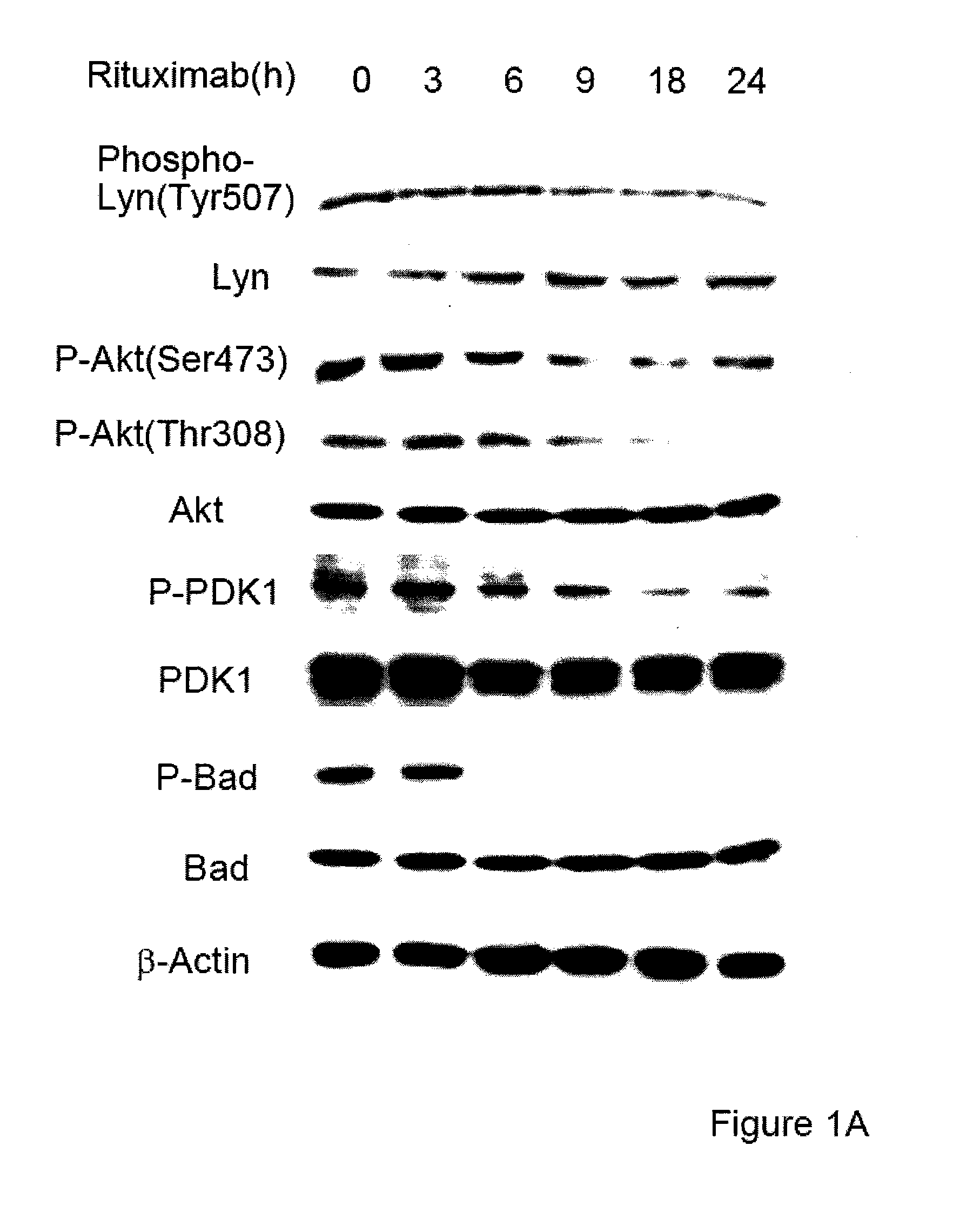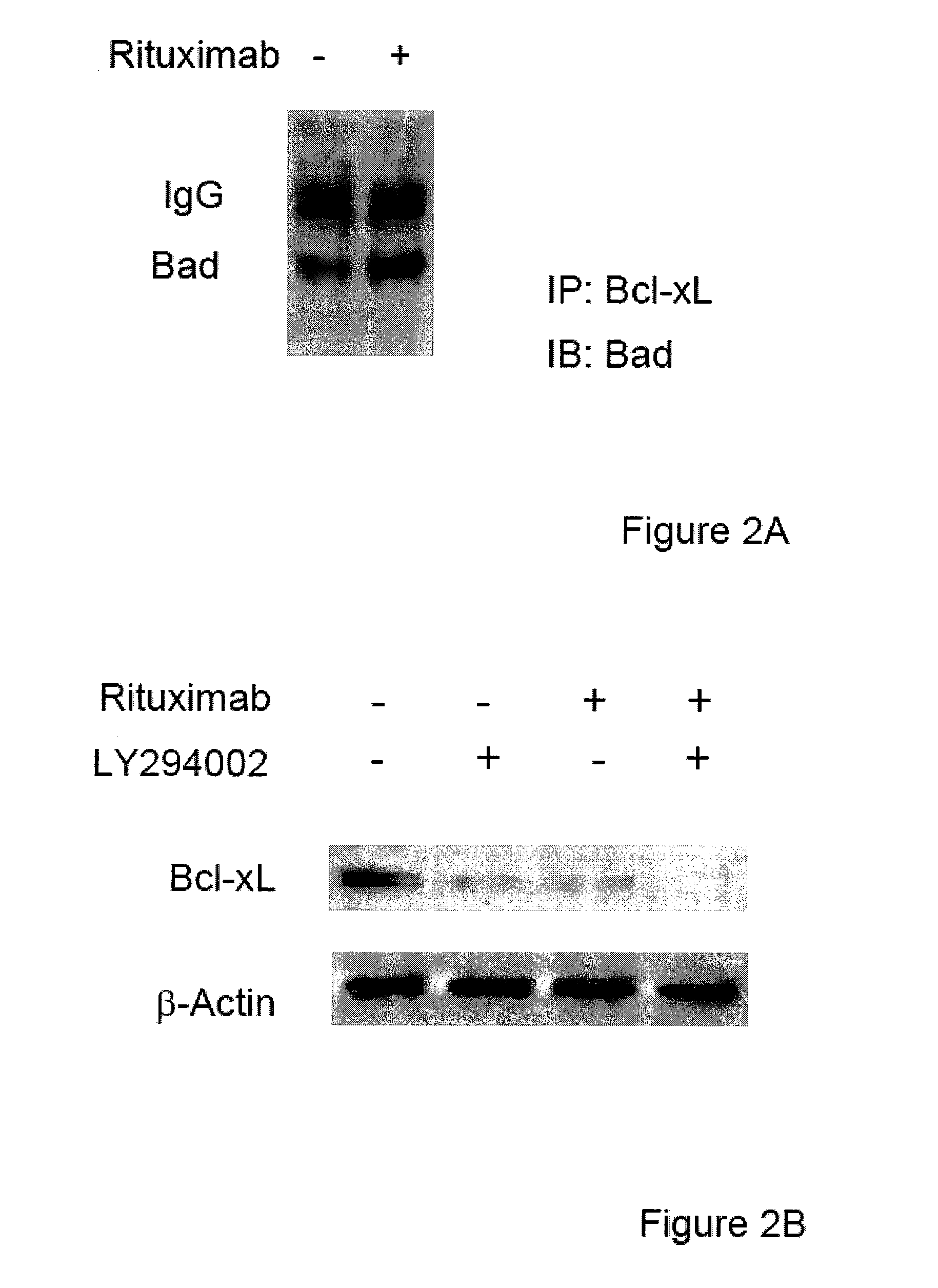Molecular signaling pathways triggered by rituximab: prognostic, diagnostic, and therapeutic uses
a technology of molecular signaling pathways and rituximab, which is applied in the direction of instruments, biochemistry apparatus and processes, measurement devices, etc., can solve the problems of not explaining the enhanced response achieved with the treatment combination of rituximab and chemotherapeutic drugs, and the failure of approximately 50% of nhl patients to respond, so as to regulate the sensitivity of cancer cells to immunotherapy
- Summary
- Abstract
- Description
- Claims
- Application Information
AI Technical Summary
Benefits of technology
Problems solved by technology
Method used
Image
Examples
example 1
Regulation of Chemoresistance and Immune Resistance of B-NHL Cell Lines by Overexpression of YY1 and Bcl-xl, Respectively: Reversal of Resistance by Rituximab
[0247] We have recently reported that treatment of B-Non-Hodgkin's Lymphoma (NHL) cell lines with rituximab (anti-CD20 antibody) sensitizes the tumor cells to both chemotherapy and Fas-induced apoptosis (Jazirehi and Bonavida, Oncogene, 24:2121-2145 (2005)). This study investigated the underlying molecular mechanism of rituximab-mediated reversal of immune and drug resistance. Treatment of B-NHL cell lines inhibited the constitutively activated NF-κB. Cells expressing dominant active IκB or treated with NF-κB specific inhibitors were sensitized to both drugs and FasL agonist mAb (CH-11)-induced apoptosis. Downregulation of Bcl-XL expression via inhibition of NF-κB activity correlated with chemosensitivity. The direct role of Bcl-XL in chemoresistance was demonstrated by the use of BC1-XL overexpressing Ramos cells, Ramos HA-Bc...
example 2
Rituximab-Mediated Inhibition of the Transcription Repressor Yin-Yang 1 (YY1) in NHL B Cell Lines: Upregulation of Fas Expression and Sensitization to Fas-Induced Apoptosis
[0248] We have reported that rituximab triggers and inhibits anti-apoptotic gene products in NHL B-cell lines resulting in sensitization to drug-induced apoptosis (Alas et al., Clin. Cancer Res., 8:836 (2001); Jazirehi et al., Mol. Cancer Therapy, 2:1183 ( 2003); Vega et al., Oncogene, 23:3530 (2004)). This study investigated whether rituximab also modifies intracellular signaling pathways resulting in the sensitization of NHL cells to Fas-induced apoptosis. Treatment of the NHL cell lines (2F7, Ramos, and Raji) with rituximab (20 μg / ml) sensitized the cells to CH-11 (FasL agonist mAb)-induced apoptosis and synergy was achieved. Fas expression was up-regulated by rituximab as early as 6 h post treatment as determined by flow cytometry, RT-PCR, and Western. Rituximab inhibited both the expression and activity of t...
example 3
Rituximab Diminishes the Constitutive Activity of the PI3k-Akt Signaling Pathway in Ramos B-NHL Cells
[0249] Rituximab (chimeric anti-CD20 monoclonal antibody) is currently being used, alone or in combination with chemotherapy, in the treatment of B-Non Hodgkin's Lymphoma (B-NHL). We have reported that rituximab treatment of B-NHL cell lines sensitizes the drug-resistant tumor cells to apoptosis by various chemotherapeutic drugs and chemosensitization was due, in large part, to the selective inhibition of the anti-apoptotic Bcl-XL gene product. The constitutive activation of the Akt pathway in B-NHL results in overexpression and functional activation of Bcl-XL. The hypothesis that the rituximab-induced inhibition of Bcl-XL expression and chemosensitization resulted, in part, from its inhibitory activity of the Akt pathway was tested using the drug-resistant Ramos B-NHL cell line. Time kinetic analysis revealed that treatment of Ramos with rituximab inhibited phophorylation of Akt (p...
PUM
| Property | Measurement | Unit |
|---|---|---|
| Volume | aaaaa | aaaaa |
| Therapeutic | aaaaa | aaaaa |
Abstract
Description
Claims
Application Information
 Login to View More
Login to View More - R&D
- Intellectual Property
- Life Sciences
- Materials
- Tech Scout
- Unparalleled Data Quality
- Higher Quality Content
- 60% Fewer Hallucinations
Browse by: Latest US Patents, China's latest patents, Technical Efficacy Thesaurus, Application Domain, Technology Topic, Popular Technical Reports.
© 2025 PatSnap. All rights reserved.Legal|Privacy policy|Modern Slavery Act Transparency Statement|Sitemap|About US| Contact US: help@patsnap.com



